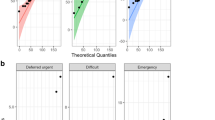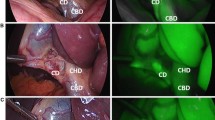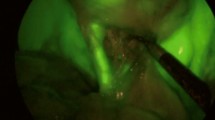Abstract
Introduction
Bile duct injury represents the most serious complication of LC, with an incidence of 0.3–0.7% resulting in a significant impact on quality-of-life, overall survival, and frequent medico-legal litigations. Near-infrared fluorescent cholangiography (NIRF-C) represents a novel intra-operative imaging technique that allows a real-time enhanced visualization of the extrahepatic biliary tree by fluorescence. The role of routine use of pre-operative magnetic resonance cholangio-pancreatography (MRCP) to better clarify the biliary anatomy before laparoscopic cholecystectomy is still a matter of debate. The primary aim of this study was to evaluate the effectiveness of NIRF-C in the detection of cystic duct-common hepatic duct anatomy intra-operatively in comparison with pre-operative MRCP.
Methods
Data from 26 consecutive patients with symptomatic cholelithiasis or chronic cholecystitis, who underwent elective laparoscopic cholecystectomy with intra-operative fluorescent cholangiography and pre-operative MRCP examination between January 2018 and May 2018, were analyzed. Three selected features of the cystic duct-common hepatic duct anatomy were identified and analyzed by the two different imaging methods: insertion of cystic duct, cystic duct-common hepatic duct junction, and cystic duct course.
Results
Fluorescent cholangiography was performed successfully in all twenty-six patients undergoing elective laparoscopic cholecystectomy. The visualization of cystic duct was reported in 23 out of 26 cases, showing an overall diagnostic accuracy of 86.9%. The level of insertion, course, and wall implantation of cystic duct were achieved by NIRF-C with diagnostic accuracy values of 65.2%, 78.3%, and 91.3%, respectively in comparison with MRCP data. No bile duct injuries were reported.
Conclusion
Fluorescent cholangiography can be considered a useful imaging diagnostic tool comparable to MRCP for detailed intra-operative visualization of the cystic duct-common hepatic duct anatomy during elective laparoscopic cholecystectomies.



Similar content being viewed by others
References
Pesce A, Portale TR, Minutolo V et al (2012) Bile duct injury during laparoscopic cholecystectomy without intraoperative cholangiography: a retrospective study on 1,100 selected patients. Dig Surg 29:310–314
Archer SB, Brown DW, Smith CD et al (2001) Bile duct injury during laparoscopic cholecystectomy: results of a national survey. Ann Surg 234(4):549–558
Woods MS (1996) Estimated costs of biliary tract complications in laparoscopic cholecystectomy based upon Medicare cost/charge ratios. Surg Endosc 10:1004–1007
Caroll BJ, Birth M, Philipps EH (1998) Common bile duct injuries during laparoscopic cholecystectomy that result in litigation. Surg Endosc 12:310–314
Griffin N, Charles-Edwards G, Grant LA (2012) Magnetic resonance cholangiopancreatography: the ABC of MRCP. Insights Imaging 3(1):11–21
Shanmugam V, Beattie GC, Yule SR et al (2005) Is magnetic resonance cholangiopancreatography the new gold standard in biliary imaging? Br J Radiol 78(934):888–893
Palmucci S, Mauro LA, Coppolino M et al (2010) Evaluation of the biliary and pancreatic system with 2D SSFSE, breathhold 3D FRFSE and respiratory-triggered 3D FRFSE sequences. Radiol Med 115(3):467–482
Palmucci S, Mauro LA, La Scola S, Incarbone S, Bonanno G, Milone P, Russo A, Ettorre GC (2010) Magnetic resonance cholangiopancreatography and contrast-enhanced magnetic resonance cholangiopancreatography versus endoscopic ultrasonography in the diagnosis of extrahepatic biliary pathology. Radiol Med 115(5):732–746
Nebiker CA, Baierlein SA, Beck S et al (2008) Is routine MR cholangiopancreatography (MRCP) justified prior to cholecystectomy? Langenbecks Arch Surg 394:447e7.5
Bahram M, Gaballa G (2010) The value of pre-operative magnetic resonance cholangiopancreatography (MRCP) in management of patients with gallstones. Int J Surg 8(5):342–345
Ausch C, Hochwarter G, Taher M et al (2005) Improving the safety of laparoscopic cholecystectomy: the routine use of preoperative magnetic resonance cholangiography. Surg Endosc 19(4):574–580
Jendresen MB, Thorboll JE, Adamsen S et al (2002) Preoperative routine magnetic resonance cholangiopancreatography before laparoscopic cholecystectomy: a prospective study. Eur J Surg. 168(12):690–694
Ishizawa T, Bandai Y, Kokudo N (2009) Fluorescent cholangiography using indocyanine green for laparoscopic cholecystectomy: an initial experience. Arch Surg 144:381–382
Pesce A, Diana M (2018) Critical view of safety during laparoscopic cholecystectomy: from the surgeon’s eye to fluorescent vision. Surg Innov 25(3):197–198
Pesce A, Latteri S, Barchitta M et al (2018) Near-infrared fluorescent cholangiography-real-time visualization of the biliary tree during elective laparoscopic cholecystectomy. HPB (Oxford) 20(6):538–545
Pesce A, Piccolo G, La Greca G et al (2015) Utility of fluorescent cholangiography during laparoscopic cholecystectomy: a systematic review. World J Gastroenterol 21(25):7877–7883
Yoshida J, Chijiiwa K, Yamaguchi K et al (1996) Practical classification of the branching types of the biliary tree: an analysis of 1,094 consecutive direct cholangiograms. J Am Coll Surg 182:37–40
Strasberg SM, Brunt LM (2010) Rationale and use of the critical view of safety in laparoscopic cholecystectomy. J Am Coll Surg 211:132–138
Conrad C, Wakabayashi G, Asbun HJ et al (2017) IRCAD recommendation on safe laparoscopic cholecystectomy. J Hepatobiliary Pancreat Sci 24:603–615
Diana M (2018) Fluorescence-guided surgery applied to the digestive system: the cybernetic eye to see the invisible (in Spanish). Cir Esp 96:65–68
Mascagni P, Longo F, Barberio M et al (2018) New intraoperative imaging technologies: innovating the surgeon’s eye toward surgical precision. J Surg Oncol 118:265–282. https://doi.org/10.1002/jso.25148
Baiocchi GL, Diana M, Boni L (2018) Indocyanine green-based fluorescence imaging in visceral and hepatobiliary and pancreatic surgery: state of the art and future directions. World J Gastroenterol 24(27):2921–2930
Dip F, Roy M, Lo Menzo E, Simpfendorfer C, Szomstein S, Rosenthal RJ (2015) Routine use of fluorescent incisionless cholangiography as a new imaging modality during laparoscopic cholecystectomy. Surg Endosc 29(6):1621–1626
Dip FD, Asbun D, Rosales-Velderrain A, Lo Menzo E, Simpfendorfer CH, Szomstein S, Rosenthal RJ (2014) Cost analysis and effectiveness comparing the routine use of intraoperative fluorescent cholangiography with fluoroscopic cholangiogram in patients undergoing laparoscopic cholecystectomy. Surg Endosc 28(6):1838–1843
Dip F, LoMenzo E, Sarotto L, Phillips E, Todeschini H, Nahmod M, Alle L, Schneider S, Kaja L, Boni L, Ferraina P, Carus T, Kokudo N, Ishizawa T, Walsh M, Simpfendorfer C, Mayank R, White K, Rosenthal RJ (2019) Randomized trial of near-infrared incisionless fluorescent cholangiography. Ann Surg. https://doi.org/10.1097/SLA.0000000000003178
Nayman A, Özbek O, Erol S et al (2016) Magnetic resonance cholangiopancreatography evaluation of intrahepatic bile duct variations with updated classification. Diagn Interv Radiol 22(6):489–494
Pesce A, Puleo S (2016) V-shaped gallbladder duplication: a rare entity to be known. Hepatobiliary Surg Nutr 5(5):447–448
Diana M, Soler L, Agnus V, D’Urso A, Vix M, Dallemagne B, Faucher V, Roy C, Mutter D, Marescaux J, Pessaux P (2017) Prospective evaluation of precision multimodal gallbladder surgery navigation: virtual reality, near-infrared fluorescence, and X-ray-based intraoperative cholangiography. Ann Surg 266(5):890–897
Schmidt R, Tannheimer M, Danz B et al (2012) Clinical relevance of a routinely performed magnetic resonance cholangiopancreatography (MRCP) prior to cholecystectomy. Zentralbl Chir 137(6):541–548
Author information
Authors and Affiliations
Corresponding author
Ethics declarations
Disclosures
Drs. Pesce, La Greca, Esposto, Basile, Puleo and Palmucci have no conflicts of interest or financial ties to disclose.
Additional information
Publisher's Note
Springer Nature remains neutral with regard to jurisdictional claims in published maps and institutional affiliations.
Rights and permissions
About this article
Cite this article
Pesce, A., La Greca, G., Esposto Ultimo, L. et al. Effectiveness of near-infrared fluorescent cholangiography in the identification of cystic duct-common hepatic duct anatomy in comparison to magnetic resonance cholangio-pancreatography: a preliminary study. Surg Endosc 34, 2715–2721 (2020). https://doi.org/10.1007/s00464-019-07158-2
Received:
Accepted:
Published:
Issue Date:
DOI: https://doi.org/10.1007/s00464-019-07158-2




